DEVELOPER INFO
GENERAL INFORMATION
XSCHEM uses layers for its graphics, each layer is a logical entity defining graphic attributes like color and fill style. There are very few graphical primitive objects:
- Lines
- Rectangles
- Open / close Polygons
- Arcs / Circles
- Text
These primitive objects can be drawn on any layer. XSCHEM number of layers can be defined at compile time, however there are some predefined layers (from 0 to 5) that have specific functions:
- Background color
- Wire color (nets)
- Selection color / grid
- Text color
- Symbol drawing color
- Pin color
- General purpose
- General purpose
- General purpose
....
- General purpose
- General purpose
Although any layer can be used for drawing it is strongly advisable to avoid the background color and the selection color to avoid confusion. Drawing begins by painting the background (layer 0), then drawing the grid (layer 1) then drawing wires (nets) on layer 2, then all graphical objects (lines, rectangles, polygons) starting form layer 0 to the last defined layer.
SYMBOLS
There is a primitive object called symbol. Symbols are just a group of primitive graphic objects (lines, polygons, rectangles, text) that can be shown as a single atomic entity. Once created a symbol can be placed in a schematic. The instantiation of a symbol is called 'component'.
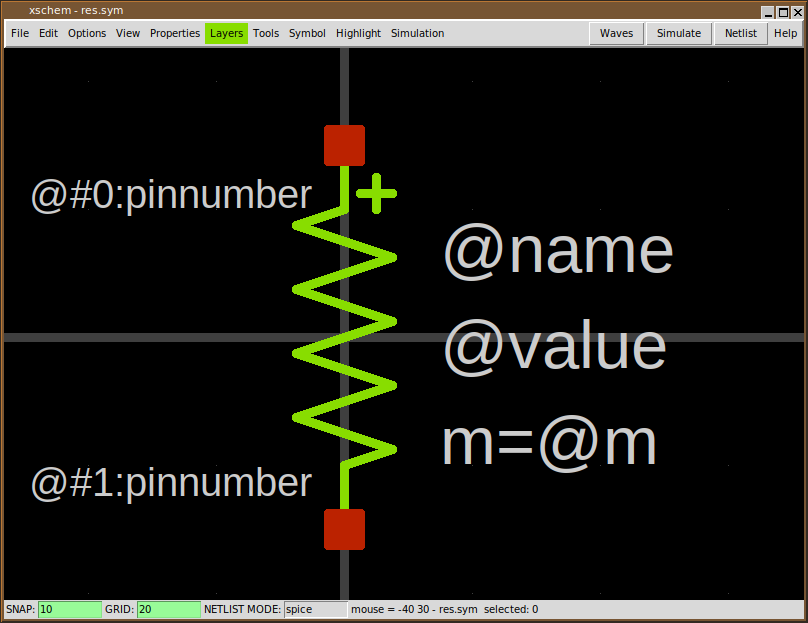
The above picture shows a resistor symbol, built drawing some lines on layer 4 (green), some pins on layer 5 (red) and some text. Symbols once created are stored in libraries (library is just a UNIX directory known to XSCHEM) and can be placed like just any other primitive object multiple times in a schematic window with different orientations.
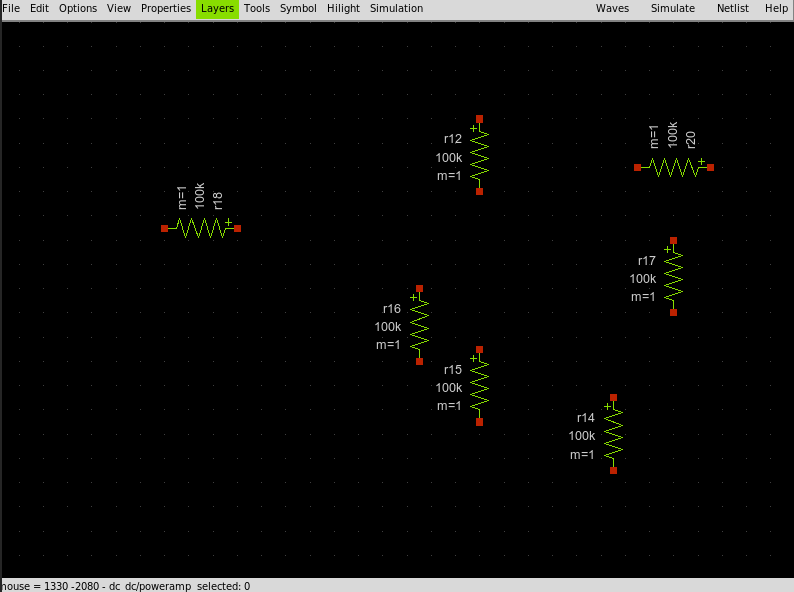
WIRES
Another special primitive object in XSCHEM is 'Wire', Graphically it is drawn as a line on layer 1 (wires). Wires are drawn only on this layer, they are treated differently by XSCHEM since they carry electrical information. Electrical connection between components is done by drawing a connecting wire.
Since wires are used to build the circuit connectivity it is best to avoid drawing lines on layer 1 to avoid confusion, since they would appear like wires, but ignored completely for electrical connectivity.
PROPERTIES
All XSCHEM objects (wires, lines, rectangles, polygons, text, symbol instance aka component) have a property string attached. Any text can be present in a property string, however in most cases the property string is organized as a set of key=value pairs separated by white space. In addition to object properties the schematic or symbol view has global properties attached. There is one global property defined per netlisting mode (currently SPICE, VHDL, Verilog, tEDAx) and one additional global property for symbols (containing the netlisting rules usually). See the XSCHEM properties section of the manual for more info.
COORDINATE SYSTEM
XSCHEM coordinates are stored as double precision floating point numbers, axis orientation is the same as Xorg default coordinate orientation:
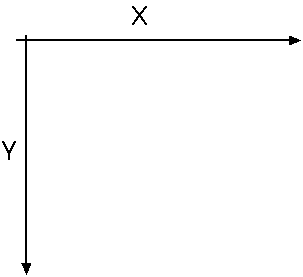
When drawing objects in XSCHEM coordinates are snapped to a multiple of 10.0 coordinate units, so all drawn objects are easily aligned. The snap level can be changed to any value by the user to allow drawing small objects if desired. Grid points are shown at multiples of 20.0 coordinate units, by default.
XSCHEM FILE FORMAT SPECIFICATION
XSCHEM schematics and symbols are stored in .sch and .sym files respectively. The two file formats are identical, with the exception that symbol (.sym) files usually do not contain wires and component instantiations (although they can).
every schematic/symbol object has a corresponding record in the file. A single character at the beginning of a line, separated by white space from subsequent fields marks the type of object:
- v : XSCHEM Version string
- S : Global property associated to the .sch file for SPICE netlisting
- V : Global property associated to the .sch file for VERILOG netlisting
- G : Global property associated to the .sch file for VHDL netlisting OR Global property associated to the .sym file for netlisting (in 1,2 file format K is used, although backward compatibility is guaranteed)
- E : Global property associated to the .sch file for tEDAx netlisting
- K : Global property associated to the .sch/sym file for netlisting.
For schematic it is used if instantiated as a component (file format 1.2 and newer) - L : Line
- B : Rectangle
- P : Open / Closed polygon
- A : Arc / Circle
- T : Text
- N : Wire, used to connect together components (only in .sch files)
- C : Component instance in a schematic (only in .sch files)
- [ : Start of a symbol embedding, the symbol refers to the immediately preceding component instance. This tag must immediately follow a component instance (C). See the example here under. A component symbol is embedded into the schematic file when saving if the embed=true attribute is set on one of the component instances. Only one copy of the embedded symbol is saved into the schematic and all components referring to this symbol will use the embedded definition. When a component has an embedded symbol definition immediately following, a embed=true is added to the component property string if not already present.
C {TECHLIB/PCH} 620 -810 0 0 {name=x5 model=PCHLV w=4 l=0.09 m=1 embed=true}
[
v {xschem version=2.9.7 file_version=1.2}
G {}
K {type=pmos
format="@name @pinlist @model w=@w l=@l m=@m"
verilog_format="@verilog_gate #(@del ) @name ( @@d , @@s , @@g );"
template=" name=x1 verilog_gate=pmos del=50,50,50 model=PCH w=0.68 l=0.07 m=1 "
generic_type="model=string"
}
V {}
S {}
E {}
L 4 5 20 20 20 {}
L 4 20 20 20 30 {}
L 4 5 -20 20 -20 {}
L 4 20 -30 20 -20 {}
L 4 -20 0 -10 0 {}
L 4 5 -27.5 5 27.5 {11}
L 4 5 -5 10 0 {}
L 4 5 5 10 0 {}
L 4 10 0 20 0 {}
L 18 -2.5 -15 -2.5 15 {}
B 5 17.5 27.5 22.5 32.5 {name=d dir=inout}
B 5 -22.5 -2.5 -17.5 2.5 {name=g dir=in}
B 5 17.5 -32.5 22.5 -27.5 {name=s dir=inout}
B 5 17.5 -2.5 22.5 2.5 {name=b dir=in}
A 4 -6.25 0 3.75 270 360 {}
T {@w/@l*@m} 7.5 -17.5 0 0 0.2 0.2 {}
T {@name} 7.5 6.25 0 0 0.2 0.2 {999}
T {@model} 2.5 -27.5 0 1 0.2 0.2 {layer=8}
T {D} 25 17.5 0 0 0.15 0.15 {layer=13}
T {NF=@nf} -5 -15 0 1 0.15 0.15 {}
]
the object tag in column 1 is followed by space separated fields that completely define the corresponding object.
VERSION STRING
Example:
v {xschem version=2.9.7 file_version=1.2}
Two attributes are defined, the xschem version and the file format version. Current file format version is 1.2. This string is guaranteed to be the first one in XSCHEM .sch and .sym files. A comment can be added (by manually editing the xschem schematic or symbol file) as shown below:
v {xschem version=3.1.0 file_version=1.2
* Copyright 2022 Stefan Frederik Schippers
*
* Licensed under the Apache License, Version 2.0 (the "License");
* you may not use this file except in compliance with the License.
* You may obtain a copy of the License at
*
* https://www.apache.org/licenses/LICENSE-2.0
*
* Unless required by applicable law or agreed to in writing, software
* distributed under the License is distributed on an "AS IS" BASIS,
* WITHOUT WARRANTIES OR CONDITIONS OF ANY KIND, either express or implied.
* See the License for the specific language governing permissions and
* limitations under the License.
}
GLOBAL SCHEMATIC/SYMBOL PROPERTIES
Example:
K {type=regulator
format="x@name @pinlist r@symname"
verilog_format="assign @#2 = @#0 ;"
tedax_format="footprint @name @footprint
device @name @symname"
template="name=U1 footprint=TO220"}
Global properties define a property string bound to the parent schematic/symbol file,
there is one global property record per netlisting mode,
currently SPICE, VHDL, Verilog, tEDAx.
In addition (only in file_format 1.2 and newer) for schematics and symbols there is a global attribute ('K')
that defines how to netlist the schematic/symbol if placed as a
symbol into another parent schematic (should be set in the same way as the 'G' global attribute for symbols
in pre-1.2 file format).
Normally only 'G' ('K' in 1.2 file format) type property strings are used for symbols and define attributes
telling netlisters what to do with the symbol, while global property
strings in schematic files corresponding to the active netlisting mode of XSCHEM are
copied verbatim to the netlist.
the object tag (S, V, G, E, K) is followed by the property string enclosed in curly braces
({...}). This allows strings to contain any white space and newlines.
Curly braces if present in the string are automatically escaped with the '\' character
by XSCHEM when saving data.
Example of the 4 property string records for a schematic file:
G {}
V {assign #1500 LDOUT = LDIN +1;
}
E {}
S {}
in this case only the verilog-related global property has some definition. This is Verilog code that is copied into the output netlist.
Attribute strings for all Xschem objects are enclosed in curly braces.
This allows attributes to span multiple lines.
This component instance:
C {capa.sym} 890 -160 0 0 {name=C4 m=1 value=10u device="tantalium capacitor"}
and this one:
C {capa.sym} 890 -160 0 0 {name=C4
m=1 value=10u
device="tantalium capacitor"
}
are perfectly equivalent.
TEXT OBJECT
Example: T {3 of 4 NANDS of a 74ls00} 500 -580 0 0 0.4 0.4 {font=Monospace layer=4}
This line defines a text object, the first field after the type tag is the displayed text,
followed by X and Y coordinates,rotation, mirror,
horizontal and vertical text size and finally a property string defining some text attributes.
- The displayed text is enclosed in curly braces ({...}) to allow white space. Literal curly braces must be escaped if present in the saved string. XSCHEM will automatically add the escapes where needed on save.
- X ad Y coordinates are saved and retrieved as double precision floating point numbers.
- Rotation and mirror are integers (range [0:3], [0:1] respectively) that define the orientation
of text objects. Using rotation and mirror text can be aligned to any corner of its bounding box, so there are 4 different
alignments for vertical text and 4 different alignments for horizontal text. Below picture shows how text is displayed
with respect to its anchor point.
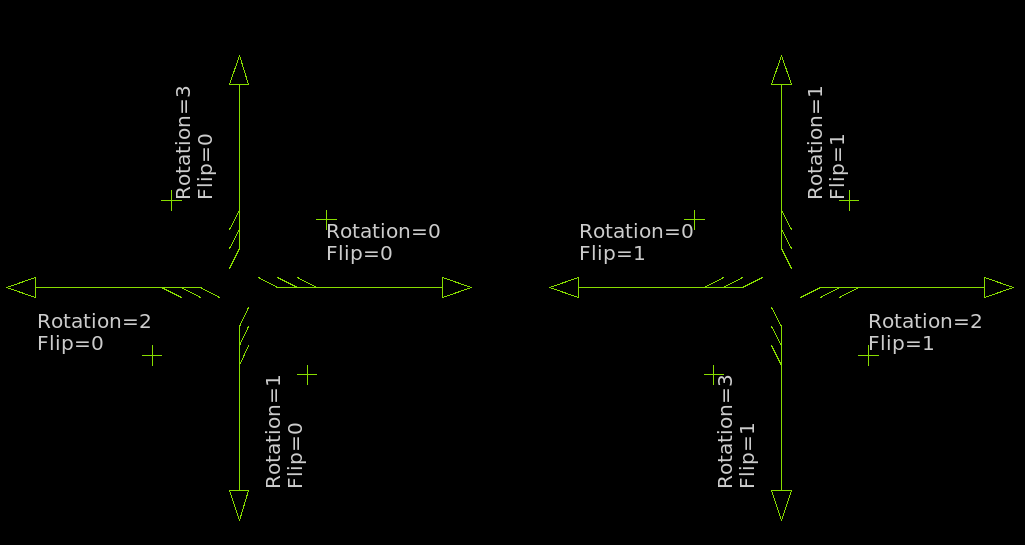
- text X and Y sizes are stored as floating point numbers.
- Finally a property string is available to attach attributes to the text object.
Currently the following attributes are predefined for text objects:
- font Name of font to be used (ex: font=Arial)
- layer Number of layer to use for drawing (as in Xschem Layers menu)
- hcenter If set to true horizontal center text
- vcenter If set to true vertical center text
- weight If set to bold use bold style
- slant If set to italic or oblique use that style for text
- hide If set to true text will be hidden unless View->Show hidden texts
is enabled
If hide=instance is given the text will be invisible in placed instances of the symbol, but visible when descending into the symbol.
WIRE OBJECT
Example: N 890 -130 890 -110 {lab=ANALOG_GND}
Format: N x1 y1 x2 y2 {attributes}
The net 'N' tag is followed by the end point coordinates x1,y1 - x2,y2.
(stored and read as double precision numbers) and a property string, used in this case to name the net.
In most cases you don't need to specify attributes for nets (one exception is the bus attribute)
as the lab attribute is set by xschem when creating a netlist or more generally when
building the connectivity.
This means that almost always nets in a xschem schematic are set as in following example:
N 890 -130 890 -110 {}
Xschem schematic files store only geometrical data and attributes of the graphic primitives,
the connectivity and the logical network is obtained by xschem.
LINE OBJECT
Example: L 4 -50 20 50 20 {This is a line on layer 4}
Format: L layer x1 y1 x2 y2 {attributes}
The line 'L' tag is followed by an integer specifying the graphic layer
followed by the x1,y1 - x2,y2 coordinates of the line and a property string.
RECTANGLE OBJECT
Example: B 5 -62.5 -2.5 -57.5 2.5 {name=IN dir=in pinnumber=1}
Format: B layer x1 y1 x2 y2 {attributes}
The 'Box' 'B' tag is followed by an integer specifying the graphic layer followed
by the x1,y1 - x2,y2 coordinates of the rectangle
and a final property string. This example defines a symbol pin.
A fill=true attribute may be given get a patterned fill (this is the default for rectangles).
A fill=false attribute may be given to avoid a fill pattern.
A fill=full attribute may be given to get a full solid fill.
Example: B 4 100 -300 400 100 {fill=false}
OPEN / CLOSED POLYGON OBJECT
Example: P 3 5 2450 -210 2460 -170 2500 -170 2510 -210 2450 -210 {}
Format: P layer npoints px1 py1 px2 py2 .... {attributes}
the Polygon 'P' tag is followed by an integer specifying the layer number,
followed by the number of points (integer),
the x,y coordinates of the polygon points and the property string (empty in this example).
If the last point is coincident to the first point a closed polygon is drawn.
A fill=true attribute may be given to fill a closed polygon, in this case a polygon line looks like:
P 3 5 2450 -210 2460 -170 2500 -170 2510 -210 2450 -210 {fill=true}
A fill=full attribute will paint the polygon with a solid full color (instead of a patterned fill).
A bezier=true attribute will transform the polygon into a bezier curve. See
the editor commands page on polygons.
ARC OBJECT
Example: A 3 450 -210 120 45 225 {}
Format: A x y r a b {attributes}
The Arc 'A' tag is followed by an integer specifying the layer number, followed by the arc x, y center coordinates,
the arc radius, the start angle (measured counterclockwise from the three o'clock direction), the arc sweep angle
(measured counterclockwise from the start angle) and the property string (empty in this example).
Angles are measured in degrees.
Arcs can be filled or not:
A fill=true attribute may be given get a patterned fill.
A fill=false attribute may be given to avoid a fill pattern. This is the default
A fill=full attribute may be given to get a full solid fill.
Circles are just arcs with a sweep angle of 360 degrees.
Example: A 4 100 -40 40 0 360 {fill=full}
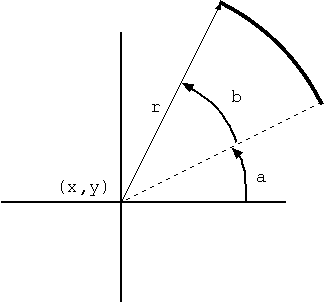
COMPONENT INSTANCE
Example: C {capa.sym} 890 -160 0 0 {name=C4 m=1 value=10u device="tantalium capacitor"}
Format: C {<symbol reference>} <X coord> <Y coord> <rotation>
<flip> {<attributes>}
The component instance tag C is followed by a string specifying library/symbol or only symbol
(see This tutorial about symbol references)
followed by the x,y coordinates, rotation (integer range [0:3]),
mirror (integer range [0:1]), and a property string defining various attributes
including the mandatory name=... attribute.
Orientation and mirror meanings are as follows:
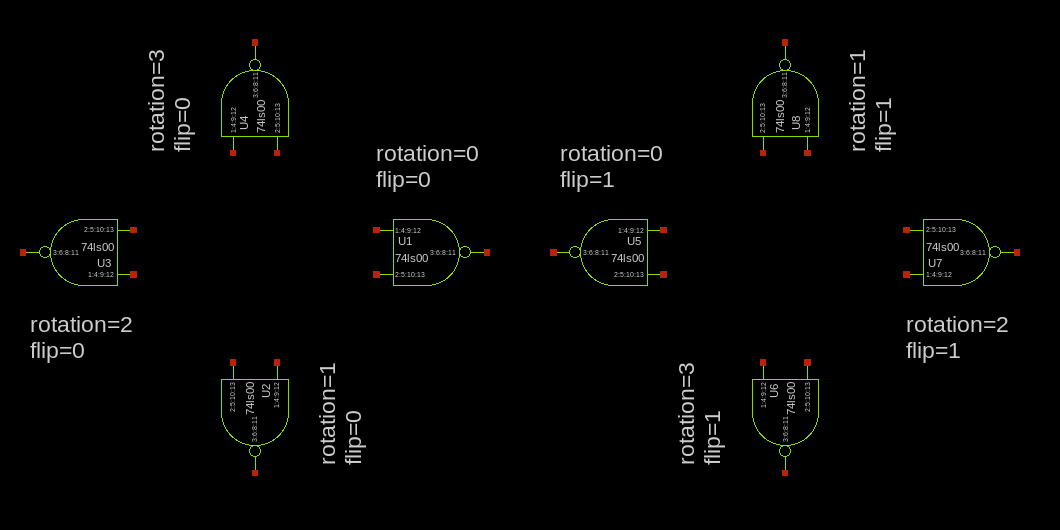
EXAMPLE OF A COMPLETE SYMBOL FILE (7805.sym)
G {}
K {type=regulator
format="x@name @pinlist r@symname"
verilog_format="assign @#2 = @#0 ;"
tedax_format="footprint @name @footprint
device @name @symname"
template="name=U1 footprint=TO220"}
V {}
S {}
E {}
L 4 -60 0 -50 0 {}
L 4 50 0 60 0 {}
L 4 -50 -20 50 -20 {}
L 4 50 -20 50 20 {}
L 4 -50 20 50 20 {}
L 4 -50 -20 -50 20 {}
L 4 0 20 0 30 {}
B 5 -62.5 -2.5 -57.5 2.5 {name=IN dir=in pinnumber=1}
B 5 -2.5 27.5 2.5 32.5 {name=GND dir=inout pinnumber=2}
B 5 57.5 -2.5 62.5 2.5 {name=OUT dir=out pinnumber=3}
T {@name} -17.5 -15 0 0 0.2 0.2 {}
T {@symname} -17.5 0 0 0 0.2 0.2 {}
T {@#0:pinnumber} -47.5 -2.5 0 0 0.12 0.12 {}
T {@#1:pinnumber} -2.5 12.5 0 0 0.12 0.12 {}
T {@#2:pinnumber} 47.5 -2.5 0 1 0.12 0.12 {}
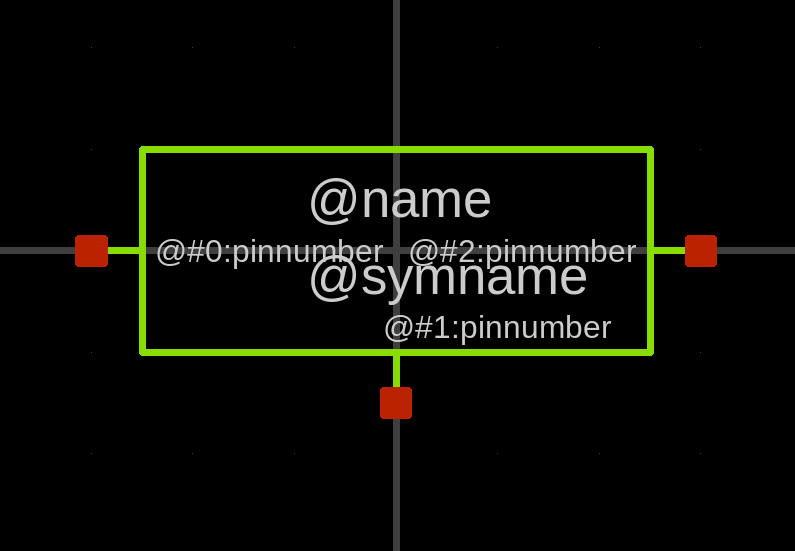
EXAMPLE OF A COMPLETE SCHEMATIC FILE (pcb_test1.sch)
G {}
K {}
V {}
S {}
E {}
B 20 270 -550 860 -290 {}
T {3 of 4 NANDS of a 74ls00} 500 -580 0 0 0.4 0.4 {}
T {EXPERIMENTAL schematic for generating a tEDAx netlist
1) set netlist mode to 'tEDAx' (Options menu -> tEDAx netlist)
2) press 'Netlist' button on the right
3) resulting netlist is in pcb_test1.tdx } 240 -730 0 0 0.5 0.5 {}
N 230 -330 300 -330 {lab=INPUT_B}
N 230 -370 300 -370 {lab=INPUT_A}
N 680 -420 750 -420 {lab=B}
N 680 -460 750 -460 {lab=A}
N 400 -350 440 -350 {lab=B}
N 850 -440 890 -440 {lab=OUTPUT_Y}
N 230 -440 300 -440 {lab=INPUT_F}
N 230 -480 300 -480 {lab=INPUT_E}
N 400 -460 440 -460 {lab=A}
N 550 -190 670 -190 {lab=VCCFILT}
N 590 -130 590 -110 {lab=ANALOG_GND}
N 790 -190 940 -190 {lab=VCC5}
N 890 -130 890 -110 {lab=ANALOG_GND}
N 730 -110 890 -110 {lab=ANALOG_GND}
N 730 -160 730 -110 {lab=ANALOG_GND}
N 590 -110 730 -110 {lab=ANALOG_GND}
N 440 -460 680 -460 {lab=A}
N 500 -420 680 -420 {lab=B}
N 500 -420 500 -350 {lab=B}
N 440 -350 500 -350 {lab=B}
C {title.sym} 160 -30 0 0 {name=l2 author="Stefan"}
C {74ls00.sym} 340 -350 0 0 {name=U1:2 risedel=100 falldel=200}
C {74ls00.sym} 790 -440 0 0 {name=U1:1 risedel=100 falldel=200}
C {lab_pin.sym} 890 -440 0 1 {name=p0 lab=OUTPUT_Y}
C {capa.sym} 590 -160 0 0 {name=C0 m=1 value=100u device="electrolitic capacitor"}
C {74ls00.sym} 340 -460 0 0 {name=U1:4 risedel=100 falldel=200 power=VCC5
url="http://www.engrcs.com/components/74LS00.pdf".sym}
C {LM7805.pdf"}
C {lab_pin.sym} 490 -190 0 0 {name=p20 lab=VCC12}
C {lab_pin.sym} 940 -190 0 1 {name=p22 lab=VCC5}
C {lab_pin.sym} 590 -110 0 0 {name=p23 lab=ANALOG_GND}
C {capa.sym} 890 -160 0 0 {name=C4 m=1 value=10u device="tantalium capacitor"}
C {res.sym} 520 -190 1 0 {name=R0 m=1 value=4.7 device="carbon resistor"}
C {lab_wire.sym} 620 -460 0 0 {name=l3 lab=A}
C {lab_wire.sym} 620 -420 0 0 {name=l0 lab=B}
C {lab_wire.sym} 650 -190 0 0 {name=l1 lab=VCCFILT}
C {connector.sym} 230 -370 0 0 {name=CONN1 lab=INPUT_A verilog_type=reg}
C {connector.sym} 230 -330 0 0 {name=CONN2 lab=INPUT_B verilog_type=reg}
C {connector.sym} 240 -190 0 0 { name=CONN3 lab=OUTPUT_Y }
C {connector.sym} 230 -480 0 0 {name=CONN6 lab=INPUT_E verilog_type=reg}
C {connector.sym} 230 -440 0 0 {name=CONN8 lab=INPUT_F verilog_type=reg}
C {connector.sym} 240 -160 0 0 { name=CONN9 lab=VCC12 }
C {connector.sym} 240 -130 0 0 { name=CONN14 lab=ANALOG_GND verilog_type=reg}
C {connector.sym} 240 -100 0 0 { name=CONN15 lab=GND verilog_type=reg}
C {code.sym} 1030 -280 0 0 {name=TESTBENCH_CODE only_toplevel=false value="initial begin
$dumpfile(\\"dumpfile.vcd\\");
$dumpvars;
INPUT_E=0;
INPUT_F=0;
INPUT_A=0;
INPUT_B=0;
ANALOG_GND=0;
#10000;
INPUT_A=1;
INPUT_B=1;
#10000;
INPUT_E=1;
INPUT_F=1;
#10000;
INPUT_F=0;
#10000;
INPUT_B=0;
#10000;
$finish;
end
assign VCC12=1;
"}
C {verilog_timescale.sym} 1050 -100 0 0 {name=s1 timestep="1ns" precision="1ns" }
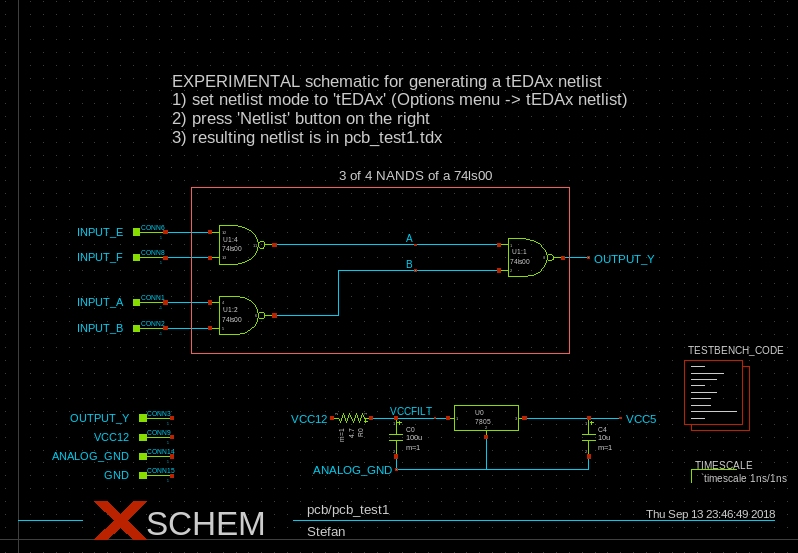
XSCHEM COMMAND REFERENCE DOCUMENTATION
The following are xschem specific tcl commands.
All commands are prefixed by the xschem keyword.
Example:
xschem getprop instance x3 OFFSET
- abort_operation
Resets UI state, unselect all and abort any pending operation
place a symbol pin. x,y : pin coordinates name = pin name dir = in|out|inout draw: 1 | 0 (draw or not the added pin immediately, default = 1) if no parameters given start a GUI placement of a symbol pin
Start a GUI placement of a graph object
Ask user to choose a png/jpg file and start a GUI placement of the image
Align currently selected objects to current snap setting
Annotate operating point data into current schematic. use <schematic name>.raw or use supplied argument as raw file to open look for operating point data and annotate voltages/currents into schematic. The optional 'level' integer specifies the hierarchy level the raw file refers to. This is necessary if annotate_op is called from a sub schematic at a hierarchy level > 0 but simulation was done at top level (hierarchy 0, for example)
Start a GUI placement of an arc. User should click 3 unaligned points to define the arc
Attach net labels to selected component(s) instance(s)
Start/end bounding box calculation: parameter is either 'begin' or 'end'
Break wires at selected instance pins if '1' is given as 'remove' parameter broken wires that are all inside selected instances will be deleted
Rebuild color palette using values of tcl vars dim_value and dim_bg
Invoke the callback event dispatcher with a software event
Set case insensitive symbol lookup. Use only on case insensitive filesystems
set selected object (instance, wire, line, rect, ...) to position 'n' in its respective array
if descended into a vector instance change inst number we are into to 'n', (same rules as 'descend' command) without going up and descending again if 'draw' string is given redraw screen
List all used symbols in current schematic and warn if some symbol is newer
Check if all instances have a unique refdes (name attribute in xschem), highlight such instances. If second parameter is '1' rename duplicates
returns index of closest object to mouse coordinates
index = type layer n
type = wire | text | line | poly | rect | arc | inst
layer is the layer number the object is drawn with
(valid for line, poly, rect, arc)
n is the index of the object in the xschem array
example:
$ after 3000 {set obj [xschem closest_object]}
(after 3s)
$ puts $obj
line 4 19
Start a GUI placement of a circle. User should click 3 unaligned points to define the circle
Clear current schematic window. Resets hierarchy level. Remove symbols the 'force' parameter will not ask to save existing modified schematic. the 'schematic' or 'symbol' parameter specifies to default to a schematic or symbol window (default: schematic)
Clears drawing but does not purge symbols
Dim colors or brite colors depending on value parameter: -5 <= value <= 5
Compare currently loaded schematic with another 'sch_file' schematic. if no file is given prompt user to choose one
Select nets/labels connected to currently selected instance if '1' argument is given, stop at wire junctions if '2' argument is given select only wires directly attached to selected instance/net if '3' argument is given combine '1' and '2'
Copy selection to clipboard
Copy hierarchy info from tab/window "from" to tab/window "to" Example: xschem copy_hierarchy .drw .x1.drw
if deltax and deltay (and optionally rot and flip) are given copy selection to specified offset, otherwise start a GUI copy operation
Debug command
Create an xplot file in netlist/simulation directory with the list of highlighted nodes in a format the selected waveform viewer understands (bespice, gaw, ngspice)
enable or disable cursors. cursor will be set at 0.0 position. use 'xschem set cursor[12]_x' to set position n: cursor number (1 or 2, for a or b) e: enable flag: 1: show, 0: hide
Cut selection to clipboard
Set xschem in debug mode.'n' is the debug level (0=no debug). Higher levels yield more debug info.
Delete selection
Bring up a file selector the user can use to delete files
Descend into selected component instance. Optional number 'n' specifies the instance number to descend into for vector instances (default: 0). 0 or 1: leftmost instance, 2: second leftmost instance, ... -1: rightmost instance,-2: second rightmost instance, ... if integer 'notitle' is given pass it to descend_schematic()
Descend into the symbol view of selected component instance
Close all additional windows/tabs. If 'force' is given do not ask for confirmation for changed schematics Returns the remaining # of windows/tabs in addition to main window/tab
Print a list of highlighted objects (nets, net labels/pins, instances) if 'instances' is specified list only instance highlights if 'nets' is specified list only net highlights
Redraw graph rectangle number 'n'. If the optional 'flags' integer is given it will be used as the flags bitmask to use while drawing (can be used to restrict what to redraw)
Perform DRC rulecheck of instances. if i is specified do check of specified instance otherwise check all instances in current schematic.
Edit xschem file of current schematic if nothing is selected. Edit .sym file if a component is selected.
Edit global schematic/symbol attributes or attributes of currently selected instances
Edit global schematic/symbol attributes or attributes of currently selected instances using a text editor (defined in tcl 'editor' variable)
Embed base 64 encoded 'raw_file' into currently selected element as a 'spice_data' attribute.
Enable/disable layers depending on tcl array variable enable_layer()
escape tcl special characters with backslash if charset is given escape characters in charset
Exit the program, ask for confirm if current file modified. if exit_code is given exit with its value, otherwise use 0 exit code if 'closewindow' is given close the window, otherwise leave with a blank schematic when closing the last remaining window if 'force' is given do not ask before closing modified schematic windows/tabs This command returns the list of remaining open windows in addition to main window
Expand vectored labels/instance names:
xschem expandlabel {2*A[3:0]} --> A[3],A[2],A[1],A[0],A[3],A[2],A[1],A[0] 8
last field is the number of bits
since [ and ] are TCL special characters argument must be quoted with { and }
After setting tcl array pixdata(n) reset fill patterns on all layers If 'nodraw' is given do not redraw window.
Set fill type for layer 'n', fill_type may be 'solid' or 'stipple' or 'empty' If 'nodraw' is given do not redraw window.
Find n-th field string separated by characters in sep. 1st field is in position 1
do not split quoted fields (if quote characters are given) and return unquoted.
xschem find_nth {aaa,bbb,ccc,ddd} {,} 2 --> bbb
xschem find_nth {aaa, "bbb, ccc" , ddd} { ,} {"} 2 --> bbb, ccc
Flip selection horizontally around point x0 y0. if x0, y0 not given use mouse coordinates
Flip selection horizontally, each object around its center
Flip selection vertically around point x0 y0. if x0, y0 not given use mouse coordinates
Flip selection vertically, each object around its center
flatten to current level selected instance texts
Toggle fullscreen modes: fullscreen with menu & status, fullscreen, normal
Get C variable/constant 'var'
- backlayer number of background layer
- bbox bounding box schematic
- bbox_hilighted bounding box of highlinhted objects
- bbox_selected bounding box of selected objects
- cadlayers number of layers
- case_insensitive case_insensitive symbol matching
- color_ps color postscript flag
- constr_mv color postscript flag
- current_dirname directory name of current design
- current_name name of current design (no library path)
- current_win_path path of current tab/window (.drw, .x1.drw, ...)
- currsch hierarchy level of current schematic (start at 0)
- cursor1_x cursor 1 position
- cursor2_x cursor 2 position
- debug_var debug level (0 = no debug, 1, 2, 3,...)
- draw_window direct draw into window
- first_sel get data about first selected object
- fix_broken_tiled_fill get drawing method setting (for broken GPUs)
- fix_mouse_coord get fix_mouse_coord setting (fix for broken RDP)
- format alternate format attribute to use in netlist (or NULL)
- graph_lastsel number of last graph that was clicked
- gridlayer layer number for grid
- help command help
- header_text header metadata (license info etc) present in schematic
- infowindow_text ERC messages
- instances number of instances in schematic
- intuitive_interface ERC messages
- last_created_window return win_path of last created tab or window
- lastsel number of selected objects
- line_width get line width
- lines (xschem get lines n) number of lines on layer 'n'
- netlist_name netlist name if set. If 'fallback' given get default name
- netlist_type get current netlist type (spice/vhdl/verilog/tedax)
- no_draw disable drawing
- ntabs get number of additional tabs (0 = only one tab)
- pinlayer layer number for pins
- raw_level hierarchy level where raw file was loaded
- rectcolor current layer number
- rects (xschem get rects n) number of rectangles on layer 'n'
- sellayer layer number for selection
- semaphore used for debug
- schname get full path of current sch. if 'n' given get sch of level 'n'
- schprop get schematic "spice" global attributes
- schvhdlprop get schematic "vhdl" global attributes
- schverilogprop get schematic "verilog" global attributes
- schsymbolprop get schematic "symbol" global attributes
- schtedaxprop get schematic "tedax" global attributes
- sch_path get hierarchy path. if 'n' given get hierpath of level 'n'
- sch_to_compare if set return schematic current design is compared with
- temp_dir get windows temporary dir
- text_svg return 1 if using <text> elements in svg export
- textlayer layer number for texts
- top_path get top hier path of current window (always "" for tabbed if)
- topwindow same as top_path but main window returned as "."
- version return xschem version
- wirelayer layer used for wires
- wires number of wires
- xschem_web_dirname
- xorigin x coordinate of origin
- yorigin y coordinate of origin
- zoom zoom level
create new symbols for instance based implementation selection
return result of get_cell function
return result of get_cell_w_ext function
getprop instance inst
Get the full attribute string of 'inst'
getprop instance inst attr
Get the value of attribute 'attr'
If 'attr has the form 'cell::sym_attr' look up attribute 'sym_attr'
of the symbol referenced by the instance.
getprop instance_notcl inst attr
Same as above but do not perform tcl substitution
getprop instance_pin inst pin
Get the full attribute string of pin 'pin' of instance 'inst'
Example: xschem getprop instance_pin x3 MINUS --> name=MINUS dir=in
getprop instance_pin inst pin pin_attr
Get attribute 'pin_attr' of pin 'pin' of instance 'inst'
Example: xschem getprop instance_pin x3 MINUS dir --> in
getprop symbol sym_name
Get full attribute string of symbol 'sym_name'
example:
xschem getprop symbol comp_ngspice.sym -->
type=subcircuit
format="@name @pinlist @symname
OFFSET=@OFFSET AMPLITUDE=@AMPLITUDE GAIN=@GAIN ROUT=@ROUT COUT=@COUT"
template="name=x1 OFFSET=0 AMPLITUDE=5 GAIN=100 ROUT=1000 COUT=1p"
getprop symbol sym_name sym_attr [with_quotes]
Get value of attribute 'sym_attr' of symbol 'sym_name'
'with_quotes' (default:0) is an integer passed to get_tok_value()
getprop rect layer num attr [with_quotes]
if '1' is given as 'keep' return backslashes and unescaped quotes if present in value
Get attribute 'attr' of rectangle number 'num' on layer 'layer'
getprop text num attr
Get attribute 'attr' of text number 'num'
if attribute is 'txt_ptr' return the text
getprop wire num attr
Get attribute 'attr' of wire number 'num'
('inst' can be an instance name or instance number)
('pin' can be a pin name or pin number)
get schematic associated with instance 'inst' if inst==-1 and a 'symbol' name is given get sch associated with symbol
get value of token 'tok' in string 'str' 'with_quotes' (default:0) is an integer passed to get_tok_value()
Get length of last looked up attribute name (not its value) if returned value is 0 it means that last searched attribute did not exist
Return various global variables used in the program
Go up one level (pop) in hierarchy if string 'notitle' is given do not update window title (slow)
grab root window
Do a simple hash of 'file' 'skip_path_lines' is an integer (default: 0) passed to hash_file()
Do a simple hashing of string 'str'
Print command help
Hierarchical postscript / pdf print if 'file' is not given show a fileselector dialog box
Highlight selected element/pins/labels/nets if 'drill' is given propagate net highlights through conducting elements (elements that have the 'propag' attribute on pins )
Highlight instance 'inst'
if 'fast' is specified do not redraw
'inst' can be an instance name or number
Highlight net name 'net'
blend_white|blend_black]
Apply required changes to selected images
invert: invert colors
white_transp: transform white color to transparent (alpha=0)
black_transp: transform black color to transparent (alpha=0)
transp_white: transform transparent to white color
transp_black: transform transparent to black color
blend_white: blend with white background and remove alpha
blend_black: blend with black background and remove alpha
write_back: write resulting image back into `image_data` attribute
Place a new instance of symbol 'sym_name' at position x,y, rotation and flip set to 'rot', 'flip' if 'prop' is given it is the new instance attribute string (default: symbol template string) if 'n' is given it must be 0 on first call and non zero on following calls It is used only for efficiency reasons if placing multiple instances
return instance and symbol bounding boxes 'inst' can be an instance name or number
Return instance name, symbol name, x placement coord, y placement coord, rotation and flip
of selected instances
if 'instance' is given (instance name or number) return data about specified instance
Example:
xschem [~] xschem instance_coord
{R5} {res.sym} 260 260 0 0
{C1} {capa.sym} 150 150 1 1
Return a list of 3-items. Each 3-item is
an instance name followed by the symbol reference and symbol type.
Example: xschem instance_list -->
{x1} {sky130_tests/bandgap.sym} {subcircuit}} {...} {...} {...} ...
Return the name of the net attached to pin 'pin' of instance 'inst' Example: xschem instance_net x3 MINUS --> REF
Return the instance name followed by a list of 'pin net' associations example: xschem instance_nodemap x3 --> x3 PLUS LED OUT LEVEL MINUS REF instance x3 pin PLUS is attached to net LED, pin OUT to net LEVEL and so on... If 'pin' is given restrict map to only that pin
Return the position of instance 'inst' in the instance array If 'n' is given set indicated instance position to 'n'
Return the name and coordinates of pin with
attribute 'attr' set to 'value' of instance 'inst'
'inst can be an instance name or a number
Example: xschem instance_pin_coord x3 name MINUS --> {MINUS} 600 -840
Return list of pins of instance 'inst' 'inst can be an instance name or a number
Get number (position) of instance name 'inst'
Return list of instances names and pins attached to net 'net'
Example: xschem instances_to_net PANEL
--> { {Vsw} {plus} {580} {-560} } { {p2} {p} {660} {-440} }
{ {Vpanel1} {minus} {600} {-440} }
tell if 'symbol' is a generator (symbol(param1,param2,...)
if 'x1 y1 x2 y2'is given place line on current layer (rectcolor) at indicated coordinates. if 'pos' is given insert at given position in rectangle array. if 'pos' set to -1 append to last element in line array. 'propstring' is the attribute string. Set to empty if not given. if 'draw' is set to 1 (default) draw the new object, else don't If no coordinates are given start a GUI operation of line placement
set line width to floating point number 'n'
List all schematics at or below current hierarchy with modification times.
Example: xschem list_hiearchy
-->
20230302_003134 {/home/.../ngspice/solar_panel.sch}
20230211_010031 {/home/.../ngspice/pv_ngspice.sch}
20221011_175308 {/home/.../ngspice/diode_ngspice.sch}
20221014_091945 {/home/.../ngspice/comp_ngspice.sch}
Sorted list of non port or non top level current level highlight nets,
separated by character 'sep' (default: space)
if `all_inst` is given list all instance hilights
if `all_nets` is given list all net hilights
if `all` is given list all hash content
List all nets with type (in / out / inout / net)
List tokens in string 'str'
with_quotes:
0: eat non escaped quotes (")
1: return unescaped quotes as part of the token value if they are present
2: eat backslashes
Load a new file 'f'. 'gui': ask to save modified file or warn if opening an already open file or opening a new(not existing) file. 'noundoreset': do not reset the undo history 'symbol': do not load symbols (used if loading a symbol instead of a schematic) 'nofullzoom': do not do a full zoom on new schematic.
Load schematic in a new tab/window. If 'f' not given prompt user
if 'f' is given as empty '{}' then open untitled.sch
If 'f' is given output stderr messages to file 'f' if 'f' is not given and a file log is open, close log file and resume logging to stderr
write given string to log file, so tcl can write messages on the log file
Get logic state of net named 'net_name' Returns 0, 1, 2, 3 for logic levels 0, 1, X, Z or nothing if no net found.
set 'net_name' to logic level 'n' 'num' times.
'n':
0 set to logic value 0
1 set to logic value 1
2 set to logic value X
3 set to logic value Z
-1 toggle logic valie (1->0, 0->1)
the 'num' parameter is essentially useful only with 'toggle' (-1) value
set selected nets, net labels or pins to logic level 'n' 'num' times.
'n':
0 set to logic value 0
1 set to logic value 1
2 set to logic value X
3 set to logic value Z
-1 toggle logic valie (1->0, 0->1)
the 'num' parameter is essentially useful only with 'toggle' (-1) value
Make a schematic from selected symbol
Create an LCC instance from selection and place it instead of selection also ask if a symbol (.sym) file needs to be created
From current schematic (circuit.sch) create a symbol (circuit.sym) using ipin.sym, opin.sym, iopin.sym in schematic to deduce symbol interface pins.
Merge another file. if 'f' not given prompt user.
resets instance coordinates, and rotaton/flip. A dash will keep existing value if 'nodraw' is given do not draw the moved instance if 'noundo' is given operation is not undoable
Start a move operation on selection and let user terminate the operation in the GUI if kissing is given add nets to pins that touch other instances or nets if stretch is given stretch connected nets to follow instace pins if dx and dy are given move by that amount.
test for my_strtok_r() function
Place a new net label
'type': 1: place a 'lab_pin.sym' label
0: place a 'lab_wire.sym' label
User should complete the placement in the GUI.
Highlight nets attached to selected symbols with a different name than symbol pin
do a netlist of current schematic in currently defined netlist format
if 'filename'is given use specified name for the netlist
if 'filename' contains path components place the file in specified path location.
if only a name is given and no path ('/') components are given use the
default netlisting directory.
This means that 'xschem netlist test.spice' and 'xschem netlist ./test.spice'
will create the netlist in different places.
netlisting directory is reset to previous setting after completing this command
If -messages is given return the ERC messages instead of just a fail (1)
or no fail (0) code.
Start a new xschem process for a schematic. If 'f' is given load specified schematic.
Open/destroy a new tab or window
create: create new empty window or with 'file' loaded if 'file' given.
The winpath must be given (even {} is ok).
non empty winpath ({1}) will avoid warnings if opening the
same file multiple times.
destroy: destroy tab/window identified by winpath. Example:
xschem new_schematic destroy .x1.drw
destroy_all: close all tabs/additional windows
if the 'force'argument is given do not issue a warning if modified
tabs are about to be closed.
switch: switch context to specified 'winpath' window or specified schematic name
If 'draw' is given and set to 0 do not redraw after switching tab
(only tab i/f)
Main window/tab has winpath set to .drw,
Additional windows/tabs have winpath set to .x1.drw, .x2.drw and so on...
dim schematic to better show highlights
Move origin to 'x, y', optionally changing zoom level to 'zoom'
A dash ('-') given for x or y will keep existing value
debug command to test parse_cmd_string() splits a command string into argv-like arguments return # of args in *argc argv[*argc] is always set to NULL
Debug command to test vector net syntax parser
Paste clipboard. If 'x y' not given user should complete placement in the GUI
List all pins of instance 'inst'
if no 'attr' is given return full attribute string,
else return value for attribute 'attr'.
Example: xschem pinlist x3 name
--> { {0} {PLUS} } { {1} {OUT} } { {2} {MINUS} }
Example: xschem pinlist x3 dir
--> { {0} {in} } { {1} {out} } { {2} {in} }
Example: xschem pinlist x3
--> { {0} {name=PLUS dir=in } } { {1} {name=OUT dir=out } }
{ {2} {name=MINUS dir=in } }
Start a GUI placement operation of specified 'sym_name' symbol. If 'sym_name' not given prompt user 'prop' is the attribute string of the symbol. If not given take from symbol template attribute.
Start a GUI placement of a text object
Start a GUI placement of a polygon
destroy: will delete preview schematic data and destroy container window close: same as destroy but leave the container window. Used in fileselector to show a schematic preview.
If img_x and img_y are set to 0 (recommended for svg and ps/pdf)
they will be calculated by xschem automatically
if img_x and img_y are given they will set the bitmap size, if
area to export is not given then use the selection boundbox if
a selection exists or do a full zoom.
Export current schematic to image.
img x y size xschem area to export
0 1 2 3 4 5 6 7 8 9
xschem print png file.png [400 300] [ -300 -200 300 200 ]
xschem print svg file.svg [400 300] [ -300 -200 300 200 ]
xschem print ps file.ps [400 300] [ -300 -200 300 200 ]
xschem print eps file.eps [400 300] [ -300 -200 300 200 ]
xschem print pdf file.pdf [400 300] [ -300 -200 300 200 ]
xschem print ps_full file.ps
xschem print pdf_full file.pdf
from highlighted nets/pins/labels:
show == 0 ==> create pins from highlight nets
show == 1 ==> show list of highlight net in a dialog box
show == 2 ==> create labels with i prefix from hilight nets
show == 3 ==> show list of highlight net with path and label
expansion in a dialog box
show == 4 ==> create labels without i prefix from hilight nets
for show = 0, 2, 4 user should complete GUI placement
of created objects
Print spice raw netlist line for instance (number or name) 'inst'
Debug: wrapper to propagate_hilights() function
Push current state on undo stack
what = add | clear | datasets | index | info | loaded | list | new | points | rawfile | del |
read | set | sim_type | switch | switch_back | table_read | value | values | vars |
xschem raw read filename [type [sweep1 sweep2]]
if sweep1, sweep2 interval is given in 'read' subcommand load only the interval
sweep1 <= sweep_var < sweep2
type is the analysis type to load (tran, dc, ac, op, ...). If not given load first found in
raw file.
xschem raw clear [rawfile [type]]
unload given file and type. If type not given delete all type sfrom rawfile
if no file is given unload all raw files.
xschem raw del name
delete named vector from current raw file
xschem raw info
print information about loaded raw files and show the currently active one.
xschem raw new name type sweepvar start end step
create a new raw file with sweep variable 'sweepvar' with number=(end - start) / step datapoints
from start value 'start' and step 'step'
xschem raw list
get list of saved simulation variables
xschem raw vars
get number of simulation variables
xschem raw switch [n | rawfile type]
make the indicated 'rawfile, type' the active one
else if a number n is specified make the n-th raw data the active one.
if no file or number is specified then switch to the next rawdata in the list.
xschem switch_back
switch to previously active rawdata.
xschem raw datasets
get number of datasets (simulation runs)
xschem raw value node n [dset]
return n-th value of 'node' in raw file
dset is the dataset to look into in case of multiple runs (first run = 0).
if dset = -1 consider n as the absolute position into the whole data file
(all datasets combined).
If n is given as empty string {} return value at cursor b,
dset not used in this case
xschem raw loaded
return hierarchy level where raw file was loaded or -1 if no raw loaded
xschem raw rawfile
return raw filename
xschem raw sim_type
return raw loaded simulation type (ac, op, tran, ...)
xschem raw index node
get index of simulation variable 'node'.
Example: raw index v(led) --> 46
xschem raw values node [dset]
print all simulation values of 'node' for dataset 'dset' (default dset=0)
dset= -1: print all values for all datasets
xschem raw points [dset]
print simulation points for dataset 'dset' (default: all dataset points combined)
xschem raw set node n value [dset]
change loaded raw file data node[n] to value
dset is the dataset to look into in case of multiple runs (first run = 0)
dset = -1: consider n as the absolute position in the whole raw file
(all datasets combined)
xschem raw table_read tablefile
read a tabular data file.
First line is the header line containing variable names.
data is presented in column format after the header line
First column is sweep (x-axis) variable
Double empty lines start a new dataset
Single empty lines are ignored
Datasets can have different # of lines.
new dataset do not start with a header row.
Lines beginning with '#' are comments and ignored
time var_a var_b var_c
# this is a comment, ignored
0.0 0.0 1.8 0.3
<single empty line: ignored>
0.1 0.0 1.5 0.6
... ... ... ...
<empty line>
<Second empty line: start new dataset>
0.0 0.0 1.8 0.3
0.1 0.0 1.5 0.6
... ... ... ...
xschem raw add varname [expr] [sweep_var]
add a 'varname' vector with all values set to 0 to loaded raw file if expr not given
otherwise initialize data with values calculated from expr.
if expr is given and also sweep_var is given use indicated sweep_var for expressions
that need it. If sweep_var not given use first raw file variable as sweep variable.
If varname is already existing and expr given recalculate data
Example: xschem raw add power {outm outp - i(@r1[i]) *}
Unload all simulation raw files You can use xschem raw clear as well.
If a raw file is already loaded delete from memory then load specified file and analysis 'sim' (dc, ac, tran, op, ...) If 'sim' not specified load first section found in raw file. if sweep1, sweep2 interval is given load only the interval sweep1 <= sweep_var < sweep2
If a simulation raw file is already loaded delete from memory else read section 'sim' (tran, dc, ac, op, ...) of base64 encoded data from a 'spice_data' attribute of selected instance If sim not given read first section found
Rebuild logical connectivity abstraction of schematic
Rebuild selection list
call the record_global_node function (list of netlist global nodes)
if 'x1 y1 x2 y2'is given place recangle on current layer (rectcolor) at indicated coordinates. if 'pos' is given insert at given position in rectangle array. if 'pos' set to -1 append rectangle to last element in rectangle array. 'propstring' is the attribute string. Set to empty if not given. if 'draw' is set to 1 (default) draw the new object, else don't If no coordinates are given start a GUI operation of rectangle placement
Redo last undone action
redraw window
Forced (be careful!) Reload current schematic from disk
Reload all used symbols from disk
Internal command: remove all symbol definitions
Replace 'inst' symbol with 'new_symbol'
If doing multiple substitutions set 'fast' to {}
on first call and 'fast' on next calls
for faster operation.
do a 'xschem redraw' at end to update screen
Example: xschem replace_symbol R3 capa.sym
Reset cached instance and symbol cached flags (inst->flags, sym->flags)
Reset instance attribute string taking it from symbol template string
This is a low level command, it merely changes the xctx->inst[...].name field. It is caller responsibility to delete all symbols before and do a reload_symbols afterward
internal command: calls resetwin()
if 'net' is given return its topmost full hierarchy name else returns the topmost full hierarchy name of selected net/pin/label. Nets connected to I/O ports are mapped to upper level recursively
Rotate selection around point x0 y0. if x0, y0 not given use mouse coordinates
Rotate selected objects around their 0,0 coordinate point
Save schematic if modified. Does not ask confirmation!
save current schematic as 'file'
if file is empty ({}) use current schematic name
as defalt and prompt user with file selector
'type' is used used to set/change file extension:
schematic: save as schematic (*.sch)
symbol: save as symbol (*.sym)
If not specified default to schematic (*.sch)
Does not ask confirmation if file name given
List a 2-item list of all pins and directions of current schematic
Example: xschem sch_pinlist
--> {PLUS} {in} {OUT} {out} {MINUS} {in} {VCC} {inout} {VSS} {inout}
When a symbol is selected edit corresponding schematic in a new tab/window if not already open. If nothing selected open another window of the second schematic (issues a warning). if 'new_process' is given start a new xschem process if 'nodraw' is given do not draw loaded schematic returns '1' if a new schematic was opened, 0 otherwise
Search instances / wires / rects / texts with attribute string containing 'tok'
and value 'val'
search can be exact ('exact') or as a regular expression ('regex')
select:
0 : highlight matching instances
1 : select matching instances
-1 : unselect matching instances
'tok' set as:
propstring : will search for 'val' in the entire
*instance* attribute string.
cell::propstring : will search for 'val' in the entire
*symbol* attribute string.
cell::name : will search for 'val' in the symbol name
cell::<attr> will search for 'val' in symbol attribute 'attr'
example: xschem search regex 0 cell::template GAIN=100
match_case:
1 : Match case
0 : Do not match case
If not given assume 1 (Match case)
select rect|line|poly|arc layer id [clear] [fast]
Select indicated instance or wire or text, or
Select indicated (layer, number) rectangle, line, polygon, arc.
For 'instance' 'id' can be the instance name or number
for all other objects 'id' is the position in the respective arrays
if 'clear' is specified does an unselect operation
if 'fast' is specified avoid sending information to infowindow and status bar
returns 1 if something selected, 0 otherwise
Selects all objects in schematic
Select all nets/labels that are dangling, ie not attached to any non pin/port/probe components Returns number of selected items (wires,labels) if danglings found, 0 otherwise
Select all highlight objects (wires, labels, pins, instances)
Select all objects inside the indicated area if [sel] is set to '0' do an unselect operation
Return a list of selected instance names If what is not given or set to 'inst' return list of selected instance names If what set to 'rect' return list of selected rectangles with their coordinates If what set to 'text' return list of selected texts with their coordinates
Return list of selected nets
Send selected wires/net labels/pins/voltage source or ammeter currents to current open viewer (gaw or bespice)
Set C variable 'var' to 'value'
- cadgrid set cad grid (default: 20)
- cadsnap set mouse snap (default: 10)
- color_ps set color psoscript (1 or 0)
- constr_mv set constrained move (1=horiz, 2=vert, 0=none)
- cursor1_x set graph cursor1 position
- cursor2_x set graph cursor2 position
- draw_window set drawing to window (1 or 0)
- fix_broken_tiled_fill alternate drawing method for broken GPUs
- fix_mouse_coord fix for wrong mouse coords in RDP software
- format set name of custom format attribute used for netlisting
- header_text set header metadata (used for license info)
- hide_symbols set to 0,1,2 for various hiding level of symbols
- hilight_color set hilight color for next hilight
- infowindow_text ERC messages
- intuitive_interface ERC messages
- netlist_name set custom netlist name
- netlist_type set netlisting mode (spice, verilog, vhdl, tedax, symbol)
- no_draw set no drawing flag (0 or 1)
- no_undo set to 1 to disable undo
- raw_level set hierarchy level loaded raw file refers to
- rectcolor set current layer (0, 1, .... , cadlayers-1)
- sch_to_compare set name of schematic to compare current window with
- schsymbolprop set global symbol attribute string
- schprop set schematic global spice attribute string
- schverilogprop set schematic global verilog attribute string
- schvhdlprop set schematic global vhdl attribute string
- schtedaxprop set schematic global tedax attribute string
- text_svg set to 1 to use svg <text> elements
- semaphore debug
- show_hidden_texts set to 1 to enable showing texts with attr hide=true
- sym_txt set to 0 to hide symbol texts
Return string 'str' replacing/adding/removing tokens that are different between 'new_str' and 'old_str'
Force modify status on current schematic
setprop instance inst [tok] [val] [fast]
set attribute 'tok' of instance (name or number) 'inst' to value 'val'
If 'tok' set to 'allprops' replace whole instance prop_str with 'val'
If 'val' not given (no attribute value) delete attribute from instance
If 'tok' not given clear completely instance attribute string
If 'fast' argument if given does not redraw and is not undoable
setprop symbol name tok [val]
Set attribute 'tok' of symbol name 'name' to 'val'
If 'val' not given (no attribute value) delete attribute from symbol
This command is not very useful since changes are not saved into symbol
and netlisters reload symbols, so changes are lost anyway.
setprop rect lay n tok [val] [fast|fastundo]
Set attribute 'tok' of rectangle number'n' on layer 'lay'
If 'val' not given (no attribute value) delete attribute from rect
If 'fast' argument is given does not redraw and is not undoable
If 'fastundo' s given same as above but action is undoable.
setprop rect 2 n fullxzoom
setprop rect 2 n fullyzoom
These commands do full x/y zoom of graph 'n' (on layer 2, this is hardcoded).
setprop text n [tok] [val] [fast|fastundo]
Set attribute 'tok' of text number 'n'
If 'tok' not specified set text string (txt_ptr) to value
If "txt_ptr" is given as token replace the text txt_ptr ("the text")
If 'val' not given (no attribute value) delete attribute from text
If 'fast' argument is given does not redraw and is not undoable
If 'fastundo' s given same as above but action is undoable.
Run a simulation (start simulator configured as default in Tools -> Configure simulators and tools) If 'callback' procedure name is given execute the procedure when simulation is finished. all execute(..., id) data is available (id = execute(id) ) A callback prodedure is useful if simulation is launched in background mode ( set sim(spice,1,fg) 0 )
Start a GUI start snapped wire placement (click to start a wire to closest pin/net endpoint)
replace 'rep' with 'with' in string 'str' if rep not preceeded by an 'escape' character
Return string 'str' with 'tok' attribute value replaced with 'newval'
When a symbol is selected edit it in a new tab/window if not already open. If nothing selected open another window of the second schematic (issues a warning). if 'new_process' is given start a new xschem process
swap cursor A (1) and cursor B (2) positions.
swap first and second window in window interface (internal command)
Switch context to indicated window path or schematic name returns 0 if switch was successfull or 1 in case of errors (no tabs/windows present or no matching winpath / schematic name found).
if 'n' given list symbol with name or number 'n', else list all used symbols
list all windows / tabs with window pathname and associated filename
If a simulation raw file is lodaded unload from memory.
else read a tabular file 'table_file'
First line is the header line containing variable names.
data is presented in column format after the header line
First column is sweep (x-axis) variable
Double empty lines start a new dataset
Single empty lines are ignored
Datasets can have different # of lines.
new dataset do not start with a header row.
Lines beginning with '#' are comments and ignored
time var_a var_b var_c
# this is a comment, ignored
0.0 0.0 1.8 0.3
<single empty line: ignored>
0.1 0.0 1.5 0.6
... ... ... ...
<empty line>
<Second empty line: start new dataset>
0.0 0.0 1.8 0.3
0.1 0.0 1.5 0.6
... ... ... ...
Testmode ...
Create a text object
x, y, rot, flip specify the position and orientation
text is the text string
props is the attribute string
size sets the size
draw is a flag. If set to 1 will draw the created text
get text string of text object 'n'
Toggle dark/light colorscheme
toggle *_ignore=true attribute on selected instances
* = {spice,verilog,vhdl,tedax} depending on current netlist mode
returns 1 if line {x1 y1 x2 y2} touches point {x0 y0}, 0 otherwise
Translate string 'str' replacing @xxx tokens with values in instance 'n' attributes
Example: xschem translate vref {the voltage is @value}
the voltage is 1.8
Translate string 'str' replacing @xxx tokens with values in string s1 or if
not found in string s2 or if not found in string s3
eat_escapes should be either 1 (remove backslashes) or 0 (keep them)
Example: xschem translate3 {the voltage is @value} {name=x12} {name=x1 value=1.8}
the voltage is 1.8
Remove leading and trailing chars matching any character in 'sep' from str
Remove operlapping wires, join lines, trim wires at intersections
Undo last action. Optional integers redo and set_modify are passed to pop_undo()
Use disk file ('disk') or RAM ('memory') for undo bufer
if 'fast' is given do not redraw Clear all highlights
Unhighlight selected nets/pins
Unselect everything. If draw is given and set to '0' no drawing is done
Update all symbol bounding boxes
update tcl ngspice::ngspice array data from raw file point 0
View attributes of selected element (read only) if multiple selection show the first element (in xschem array order)
Highlight or select (if 'sel' set to 1) perfectly overlapped instances this is usually an error and difficult to grasp visually
Used by xschem.tcl for configure events (set icon)
return 4 coordinates of wire[n]
Place a new wire if no coordinates are given start a GUI wire placement
start a wire cut operation. Point the mouse in the middle of a wire and Alt-click right button. if x and y are given cut wire at given point if noalign is given and is set to 'noalign' do not align the cut point to closest snap point
For debug
Zoom to specified coordinates, if 'factor' is given reduce view (factor < 1.0) or add border (factor > 1.0) If no coordinates are given start GUI zoom box operation
Set full view. If 'center' is given center vire instead of lower-left align If 'nodraw' is given don't redraw If 'nolinewidth]' is given don't reset line widths.
Zoom to highlighted objects
Zoom in drawing
Zoom out drawing
Zoom to selection
XSCHEM TCL GLOBAL VARIABLES
# default command for first spice simulation command (interactive ngspice)
sim(spice,0,cmd) {$terminal -e 'ngspice -i "$N" -a || sh'}
# flag for foreground (1) or background (0) operation
sim(spice,0,fg) 0
# flag for status dialog box opening (1) at simulation end or not (0)
sim(spice,0,st) 0
sim(spice,1,cmd) {ngspice -b -r "$n.raw" -o "$n.out" "$N"}
sim(spice,1,fg) 0
sim(spice,1,st) 1
sim(spice,2,cmd) "Xyce \"\$N\"\n# Add -r \"\$n.raw\" if you want all variables saved"
sim(spice,2,fg) 0
sim(spice,2,st) 1
sim(spice,3,cmd) {mpirun /path/to/parallel/Xyce "$N"}
sim(spice,3,fg) 0
sim(spice,3,st) 1
# Number of configured spice simulation commands (4), [ sim(spice,0,...) ... sim(spice,3,...) ]
sim(spice,n) 4
# default spice command to use (0) --> sim(spice,0,...)
sim(spice,default) 0
sim(spicewave,0,cmd) {gaw "$n.raw" }
sim(spicewave,0,fg) 0
sim(spicewave,0,st) 0
sim(spicewave,1,cmd) {$terminal -e ngspice}
sim(spicewave,1,fg) 0
sim(spicewave,1,st) 0
sim(spicewave,2,cmd) {rawtovcd -v 1.5 "$n.raw" > "$n.vcd" && gtkwave "$n.vcd" "$n.sav" 2>/dev/null}
sim(spicewave,2,fg) 0
sim(spicewave,2,st) 0
sim(spicewave,3,cmd) {$env(HOME)/analog_flavor_eval/bin/bspwave --socket localhost $bespice_listen_port "$n.raw" }
sim(spicewave,3,fg) 0
sim(spicewave,3,st) 0
sim(spicewave,n) 4
sim(spicewave,default) 0
# list of configured tools. For each of these there is a set of sim(tool,...) settings
sim(tool_list) spice spicewave verilog verilogwave vhdl vhdlwave
sim(verilog,0,cmd) {iverilog -o .verilog_object -g2012 "$N" && vvp .verilog_object}
sim(verilog,0,fg) 0
sim(verilog,0,st) 1
sim(verilog,n) 1
sim(verilog,default) 0
sim(verilogwave,0,cmd) {gtkwave dumpfile.vcd "$N.sav" 2>/dev/null}
sim(verilogwave,0,fg) 0
sim(verilogwave,0,st) 0
sim(verilogwave,n) 1
sim(verilogwave,default) 0
sim(vhdl,0,cmd) {ghdl -c --ieee=synopsys -fexplicit "$N" -r "$s" --wave="$n.ghw"}
sim(vhdl,0,fg) 0
sim(vhdl,0,st) 1
sim(vhdl,n) 1
sim(vhdl,default) 0
sim(vhdlwave,0,cmd) {gtkwave "$n.ghw" "$N.sav" 2>/dev/null}
sim(vhdlwave,0,fg) 0
sim(vhdlwave,0,st) 0
sim(vhdlwave,n) 1
sim(vhdlwave,default) 0
add_all_windows_drives 1
autofocus_mainwindow 1
auto_hilight 0
autotrim_wires 0
bespice_listen_port {}
bespice_server_getdata
big_grid_points 0
bus_replacement_char {} ;# use {<>} to replace [] with <> in bussed signals
cadlayers 22
cairo_font_line_spacing 1.0
cairo_font_name {Sans-Serif}
cairo_font_scale 1.0
cairo_vert_correct 0
case_insensitive 0
change_lw 1
color_ps 1
colors $dark_colors
compare_sch 0
component_browser_on_top 1
connect_by_kissing 0
constrained_move 0
copy_cell 0
dark_colors {
"#000000" "#00ccee" "#3f3f3f" "#cccccc" "#88dd00" "#bb2200" "#00ccee" "#ff0000"
"#ffff00" "#ffffff" "#ff00ff" "#00ff00" "#0044dd" "#aaaa00" "#aaccaa" "#ff7777"
"#bfff81" "#00ffcc" "#ce0097" "#d2d46b" "#ef6158" "#fdb200"}
dark_colorscheme 1
dark_colors_save
debug_var 0
delay_flag
dim_bg 0.0
dim_value 0.0
dircolor(/share/doc/xschem/) {#338844}
dircolor(/share/xschem/) red
disable_unique_names 0
download_url_helper {curl -f -s -O}
draw_grid 1
draw_window 0
editor {gvim -f}
edit_prop_size 80x12
edit_symbol_prop_new_sel {}
enable_dim_bg 0
enable_layer($i) 1
enable_stretch 0
en_hilight_conn_inst 0
execute(cmd,<id>)
execute(data,<id>)
execute(status,<id>)
execute(cmd,last)
execute(data,last)
execute(status,last)
execute(error,last)
execute(exitcode,last)
execute(id)
flat_netlist 0
fullscreen 0
gaw_tcp_address {localhost 2020}
graph_bus 0
graph_logx 0
graph_logy 0
graph_rainbow 0
graph_raw_level -1 ;# hierarchy level where raw file has been loaded
graph_schname {}
graph_sel_color 4
graph_selected {}
graph_sel_wave {}
graph_sort 0
has_cairo 1
has_x
hide_empty_graphs 0 ;# if set to 1 waveform boxes will be hidden if no raw file loaded
hide_symbols 0
incr_hilight 1
# text saved into the ERC informational dialog box.
# netlist warnings and errors are shown here.
infowindow_text
initial_geometry {900x600}
launcher_default_program {xdg-open}
light_colors {
"#ffffff" "#0044ee" "#aaaaaa" "#222222" "#229900" "#bb2200" "#00ccee" "#ff0000"
"#888800" "#00aaaa" "#880088" "#00ff00" "#0000cc" "#666600" "#557755" "#aa2222"
"#7ccc40" "#00ffcc" "#ce0097" "#d2d46b" "#ef6158" "#fdb200"}
light_colors_save
line_width 0
live_cursor2_backannotate 0
# if set use <sch_dir>/simulation for netlist and sims
local_netlist_dir 0
lvs_ignore 0
lvs_netlist 0
measure_text "y=\nx="
menu_debug_var 0
myload_files2 {}
myload_globfilter {*}
myload_index1 0
netlist_dir "$USER_CONF_DIR/simulations"
netlist_show 0
netlist_type spice
nocairo_font_xscale .85
nocairo_font_yscale .88
nocairo_vert_correct 0
no_change_attrs 0
nolist_libs {}
noprint_libs {}
only_probes 0 ; # 20110112
OS
persistent_command 0
preserve_unchanged_attrs 0
rainbow_colors 0
search_schematic 0
show_hidden_texts 0
show_infowindow 0
show_infowindow_after_netlist 0
show_pin_net_names 0
spiceprefix 1
split_files 0
svg_font_name {Sans-Serif}
symbol_width 150
sym_txt 1
tabbed_interface 0
tcl_files {}
tclstop 0
terminal xterm
text_line_default_geometry 80x12
textwindow_wcounter
toolbar_horiz 1
toolbar_list { ... }
toolbar_visible 0
to_pdf {ps2pdf}
to_png {gm convert}
transparent_svg 0
undo_type disk
unzoom_nodrift 0
use_tclreadline 1 ;# use the tclreadline package for command prompt. default: 1
USER_CONF_DIR
verilog_2001 1
verilog_bitblast 0
viewdata_wcounter
xschem_libs {}
xschem_listen_port {}
xschem_server_getdata
XSCHEM_SHAREDIR
XSCHEM_START_WINDOW {}
XSCHEM_TMP_DIR {/tmp}
zoom_full_center 0
Simulator / waveform setup
In xschem a tcl array variable sim is used to specify external process commands, like simulators and waveform viewers. This variable is set in the GUI with the Simulation-> Configure simulators and tools menu entry. First of all you need to set the tool_list list of configured tools:
set sim(tool_list) { spice spicewave verilog verilogwave vhdl vhdlwave }
For each tool you need to define some sub elements:
# Number of configured spice simulation commands (4), [ sim(spice,0,...) ... sim(spice,3,...) ]
sim(spice,n) 4
# default spice command to use (0) --> sim(spice,0,...)
sim(spice,default) 0
# default command for first spice simulation command (interactive ngspice)
sim(spice,0,cmd) {$terminal -e 'ngspice -i "$N" -a || sh'}
# flag for foreground (1) or background (0) operation
sim(spice,0,fg) 0
# flag for status dialog box opening (1) at simulation end or not (0)
sim(spice,0,st) 0
sim(spice,1,cmd) {ngspice -b -r "$n.raw" -o "$n.out" "$N"}
sim(spice,1,fg) 0
sim(spice,1,st) 1
sim(spice,2,cmd) "Xyce \"\$N\"\n# Add -r \"\$n.raw\" if you want all variables saved"
sim(spice,2,fg) 0
sim(spice,2,st) 1
sim(spice,3,cmd) {mpirun /path/to/parallel/Xyce "$N"}
sim(spice,3,fg) 0
sim(spice,3,st) 1
XSCHEM TCL PROCEDURES
Commands in brackets are internal procedures, not supposed to be used by end users
# show xschem about dialog
about
# given a symbol reference 'sym' return its absolute path
# Example: % abs_sym_path devices/iopin.sch
# /home/schippes/share/xschem/xschem_library/devices/iopin.sym
abs_sym_path sym
add_ext
add_lab_no_prefix
add_lab_prefix
# show an alert dialog box and display 'text'.
# if 'position' is empty (example: alert_ {hello, world} {}) show at mouse coordinates
# otherwise use specified coordinates example: alert_ {hello, world} +300+400
# if nowait is 1 do not wait for user to close dialog box
# if yesnow is 1 show yes and no buttons and return user choice (1 / 0).
# (this works only if nowait is unset).
alert_ text [position] [nowait] [yesno]
ask_save
attach_labels_to_inst
balloon
balloon_show
bespice_getdata
bespice_server
build_widgets
change_color
clear_simulate_button
color_dim
context_menu
convert_to_pdf
convert_to_png
create_layers_menu
create_pins
# pause execution for 'ms milliseconds, keeping event loop responding
delay [ms]
delete_ctx
delete_files
delete_tab
descend_hierarchy
download_url
edit_file
edit_netlist
edit_prop
edit_vi_netlist_prop
edit_vi_prop
enter_text
# evaluate 'expr'. if 'expr' has errors or does not evaluate return 'expr' as is
ev expr
every
execute
execute_fileevent
execute_wait
fill_graph_listbox
# find file into $paths directories matching $f
# use $pathlist global search path if $paths empty
# recursively descend directories
find_file f [paths]
# as above, return only first match found
find_file_first f [paths]
# process all symbols in current design, get full path of them if found in
# XSCHEM_LIBRARY_PATH search path, then transform them with exactly one 'n_dir'
# path components added.
# example: current design has an instance referencing 'lab_pin.sym'
# after executing 'fix_symbols 1' the instance symbol reference
# will be devices/lab_pin.sym. This will be done only on symbols
# that are existing in the current search paths (there is
# devices/lab_pin.sym in one of the search paths).
fix_symbols n_dirs
from_eng
gaw_cmd
gaw_echoline
get_cell
get_directory
get_file_path
# launch a terminal shell, if 'curpath' is given set path to 'curpath'
get_shell
graph_add_nodes
graph_add_nodes_from_list
graph_change_wave_color
graph_edit_properties
graph_edit_wave
graph_get_signal_list
graph_show_measure
graph_update_nodelist
hash_string
history
housekeeping_ctx
infowindow
input_line
inutile
inutile_alias_window
inutile_get_time
inutile_help_window
inutile_line
inutile_read_data
inutile_template
inutile_translate
inutile_write_data
is_xschem_file
key_binding
launcher
list_hierarchy
list_tokens
load_file_dialog
load_file_dialog_mkdir
load_file_dialog_up
load_recent_file
make_symbol
make_symbol_lcc
# find files into $paths directories matching $f
# use $pathlist global search path if $paths empty
# recursively descend directories
match_file f [paths]
myload_display_preview
myload_getresult
myload_place_symbol
myload_set_colors1
myload_set_colors2
myload_set_home
netlist
next_tab
no_open_dialogs
order
pack_tabs
pack_widgets
path_head
pin_label
prev_tab
print_help_and_exit
probe_net
property_search
# quit xschem closing all tabs/windows (including the first/main)
# user has the option to cancel the closing of modified tabs/windows
# if 'force' is given no confirmation is asked and modified content is lost.
# the number of schematic views left over (in addition to main window)
# is returned. If only one (the main view) is left command returns 0.
quit_xschem [force]
raise_dialog
read_data
read_data_nonewline
read_data_window
reconfigure_layers_button
reconfigure_layers_menu
rectorder
redef_puts
# Given an absolute path 'symbol' of a symbol/schematic remove the path prefix
# if file is in a library directory (a $pathlist dir)
# Example: rel_sym_path /home/schippes/share/xschem/xschem_library/devices/iopin.sym
# devices/iopin.sym
rel_sym_path symbol
reroute_inst
reroute_net
reset_colors
restore_ctx
return_release
rotation
save_ctx
save_file_dialog
save_sim_defaults
schpins_to_sympins
select_inst
select_layers
set_bindings
set_env
set_graph_linewidth
set_initial_dirs
set_missing_colors_to_black
# set 'var' with '$val' if 'var' not existing
set_ne var val
# set_netlist_dir force [path]
# if path is given set as new netlist path where netlists and simulations are done.
# force should be always set to 1 unless you just want to query current path.
# select_netlist_dir 0 will return current path (you can get with $netlist_dir as well)
set_netlist_dir
set_old_tk_fonts
# when XSCHEM_LIBRARY_PATH is changed this function is called
# by 'trace_set_paths' refresh and cache new library search paths.
set_paths
set_replace_key_binding
# Initialize the tcl sim array variable (if not already set)
# setting up simulator / wave viewer commands
set_sim_defaults
set_tab_names
setglob
setup_recent_menu
setup_tabbed_interface
setup_tcp_bespice
setup_tcp_gaw
setup_tcp_xschem
setup_toolbar
sframe
# show ERC (electrical rule check) dialog box
show_infotext
simconf
simconf_add
simconf_reset
simconf_saveconf
sim_is_ngspice
sim_is_xyce
sim_is_Xyce
simulate
simulate_button
simuldir
source_user_tcl_files
sub_find_file
sub_match_file
swap_compare_schematics
swap_tabs
# show a dialog box asking user to switch undo bguffer from memory to disk
switch_undo
# evaluate a tcl command from GUI
tclcmd
tclcmd_ok_button
tclpropeval
tclpropeval2
text_line
textwindow
to_eng
tolist
toolbar_add
toolbar_hide
toolbar_show
# this function executes whenever XSCHEM_LIBRARY_PATH changes (registered
# with a 'trace' command)
trace_set_paths
try_download_url
update_div
update_graph_node
update_recent_file
update_schematic_header
view_current_sim_output
waves
write_data
write_recent_file
xschem_getdata
xschem_server
SOME USEFUL SCRIPT EXAMPLES
The following examples show the xschem commands one by one. In general you should create small TCL procedures to perform these tasks. This way you can optimize things, for example creating temporary variables holding the output of the various xschem ... commands.
-
Instantiate a component and wire it up with specific nets on its terminals.
-
Disable a component in the schematic
-
Delete a component together with its attached nets
-
Delete dangling nets and labels
-
Change attributes of a group of components
-
Copy a components with its wired terminals
-
Transform a component into a short
-
Move a selected portion of the schematic
-
Rotate a selected portion of the schematic
-
Flip a selected portion of the schematic
-
Rotate in place a selected portion of the schematic
-
Move a wired object
-
Add and wire parallel devices
-
Replace symbols
# Create a 5V Vvdd voltage source
xschem instance vsource.sym 100 100 0 0 {name=Vvdd value=5}
|
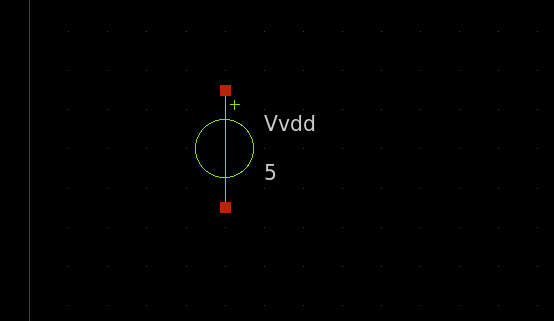 |
# Attach labels, They will get the symbol pin labels xschem select instance vvdd xschem attach_labels |
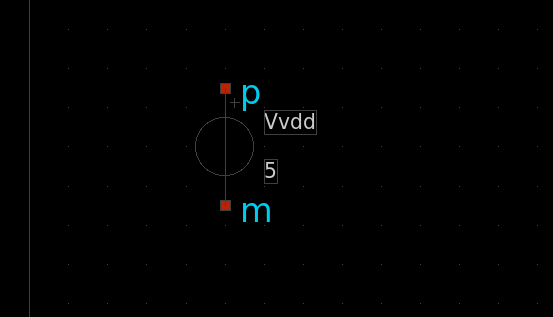 |
# Select labels, unselect vsource and change positive and negative terminal # labels to VCC and GND respectively # The first item in the selected_set list is the first vsource terminal # (the positive terminal), the second one is the negative terminal. # At the end unselect all xschem connected_nets xschem select instance Vvdd clear xschem setprop instance [lindex [xschem selected_set] 0] lab VCC xschem setprop instance [lindex [xschem selected_set] 1] lab GND xschem unselect_all |
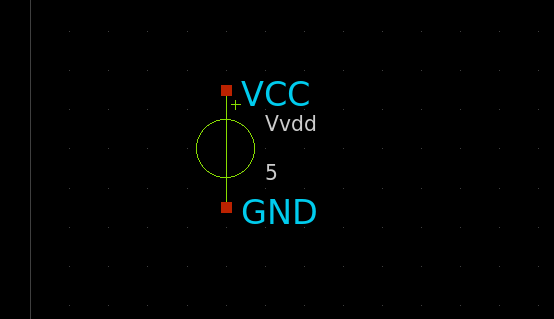 |
# Add spice_ignore=true attribute # the component will be ignored in generated netlists. xschem setprop instance Vvdd spice_ignore true |
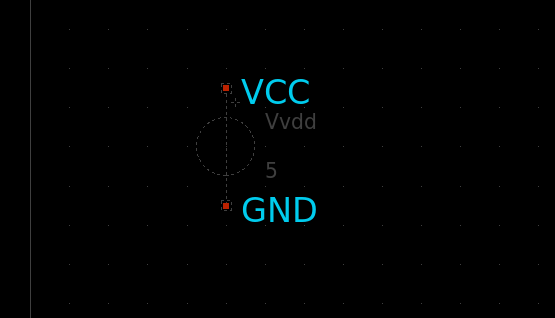 |
# select component, select attached nets and delete # this will also select wire segments if labels are attached to selected instance with wires. xschem select instance Vvdd xschem connected_nets |
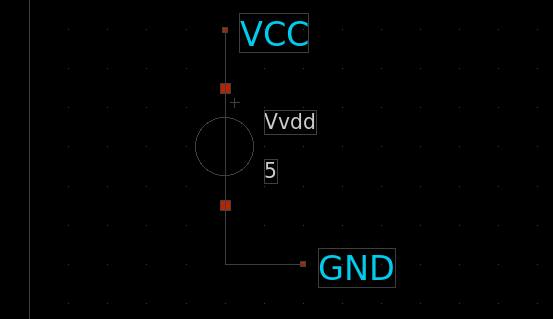 |
# Delete selection xschem delete |
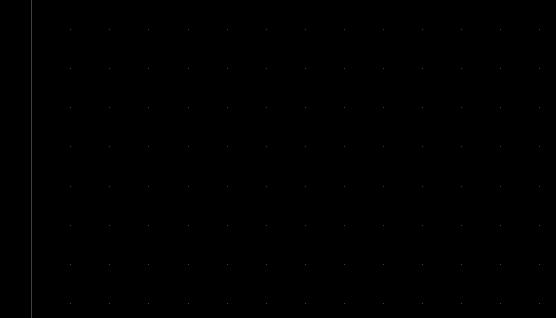 |
# If after some editing or deletions dangling nets are present # they can all be selected. Deletion may be done with a "xschem delete" command. xschem select_dangling_nets |
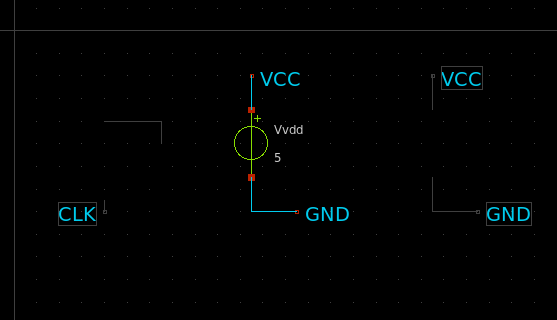 |
# From this situation we want to select all MOS elements with L=2 # and modify L (gate length) to 3 |
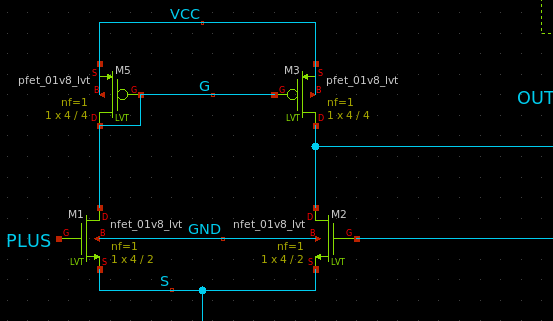 |
# Do an exact search of elements with L=2
xschem search exact 1 L 2
# a more precise search to avoid selecting unwanted elements might be:
# xschem search regex 1 propstring "L=2\[ \n\].*model=nfet"
# the above command will do a regular expression search on the whole
# instance property string (the special token propstring)
foreach i [xschem selected_set] { xschem setprop instance $i L 3}
xschem unselect_all
|
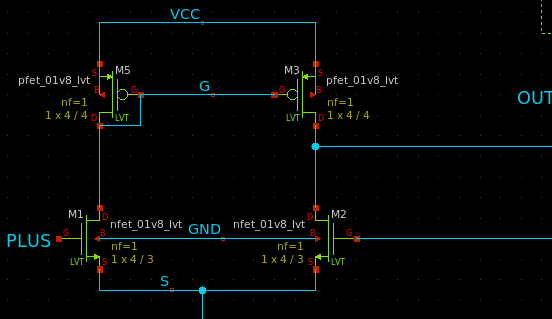 |
# From this situation we want to copy Vvdd to a different location # and change the instance name, voltage value and its positive terminal net name |
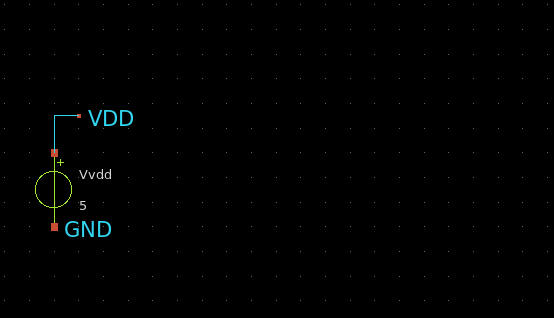 |
# select the desired instance xschem select instance Vvdd # select attached wires xschem connected_nets # Copy to clipboard xschem copy # Paste selection 150 x-axis units to the right xschem paste 150 0 # First selected_set item is the voltage source (it was selected first) xschem setprop instance [lindex [xschem selected_set] 0] name Vvpp xschem setprop instance [lindex [xschem selected_set] 0] value 12 # Following item is the net label attached to the first symbol pin xschem setprop instance [lindex [xschem selected_set] 1] lab VPP |
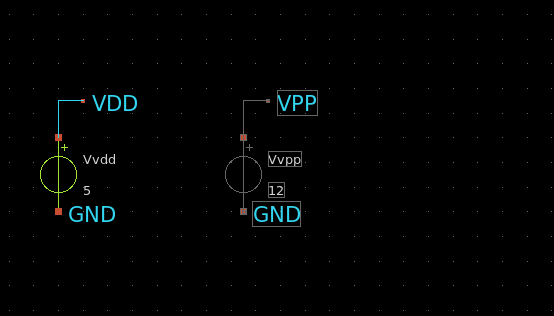 |
# We want to transform this voltage source into a short, passing the # negative label onto the positive terminal. # Warning: no net label must be present on the positive net, otherwise you end up with # an ERC error (multiple differnet labels on the same net) |
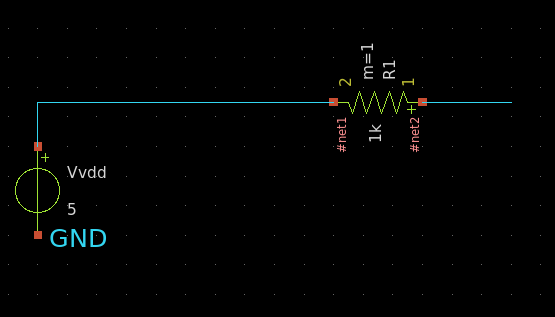 |
# add spice_ignore=short attribute to instance # All pins of the instance will be shorted together to the same net. # Instance will be shown in red to indicate the short condition. # Option "Options->Show net name on symbol pins" is enabled and attribute # net_name=true is set on the resistor to show net names. # you see the left resistor terminal is GND now. xschem setprop instance Vvdd spice_ignore short |
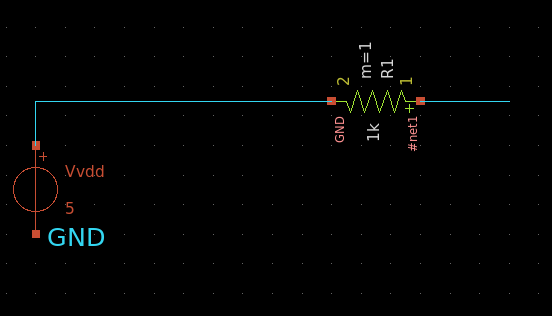 |
# After selecting some objects... |
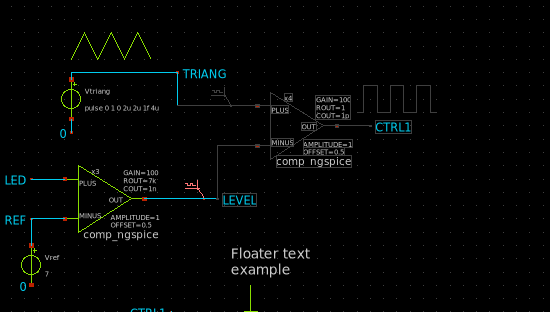 |
# ... We move them by some X / Y quantities. xschem move_objects 100 0 |
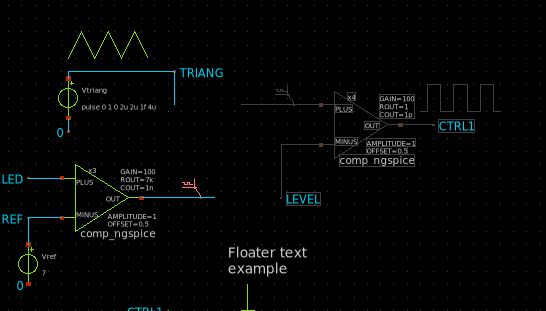 |
# After selecting some objects ... |
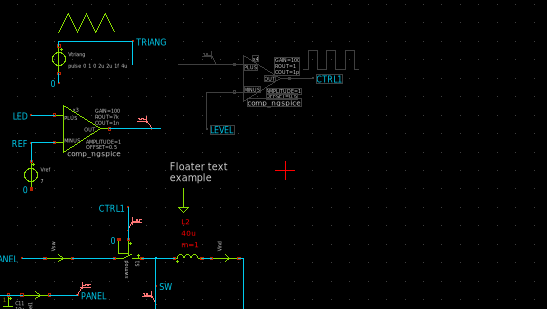 |
# ... We rotate them clockwise around point 1100,-800 (shown with the red cross) xschem rotate 1100 -800 |
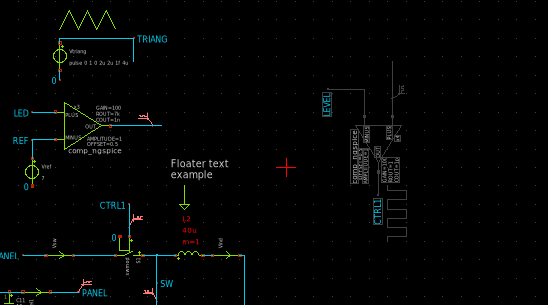 |
# After selecting some objects as before ... # ... We flip them horizontally around point 1100,-800 (shown with the red cross) xschem flip 1100 -800 |
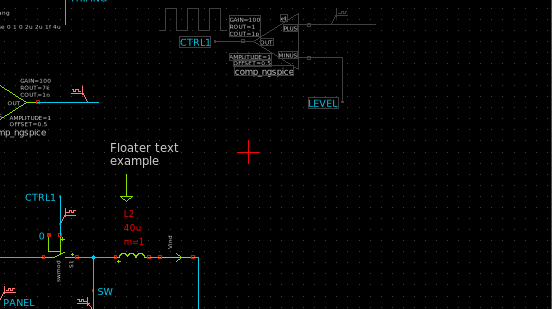 |
# After selecting some objects ... |
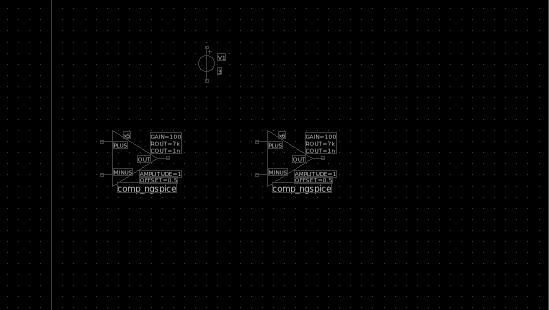 |
# ... We rotate clockwise each object around their origins # the same command 'flip_in_place' is available for flipping horizontally. xschem rotate_in_place |
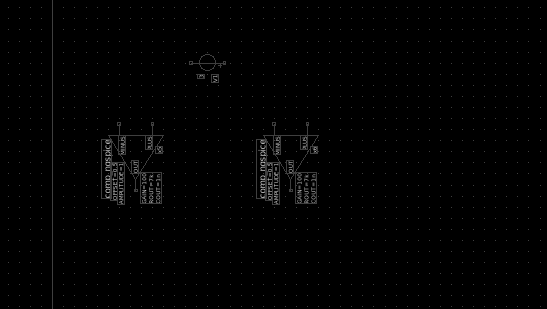 |
# After selecting some objects ... |
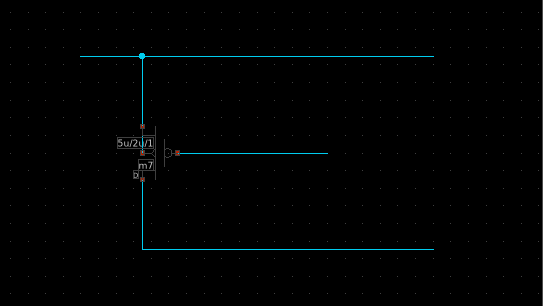 |
# ... we select only the first segments attached to their pins ... xschem connected_nets 2 |
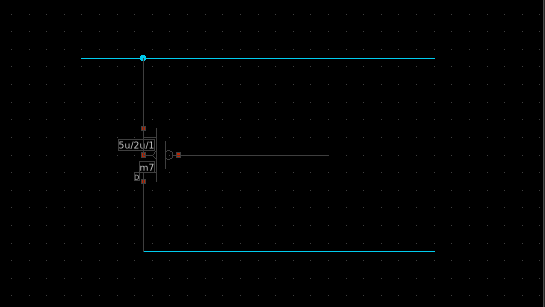 |
# ... And then move the selection. xschem move_objects 100 0 |
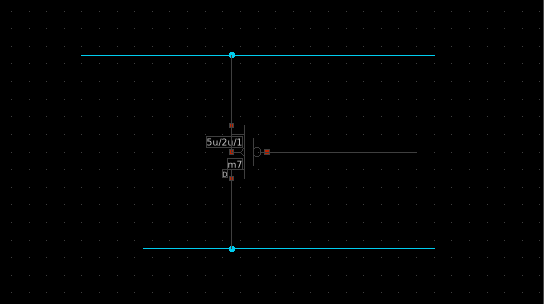 |
# Given this instance ... |
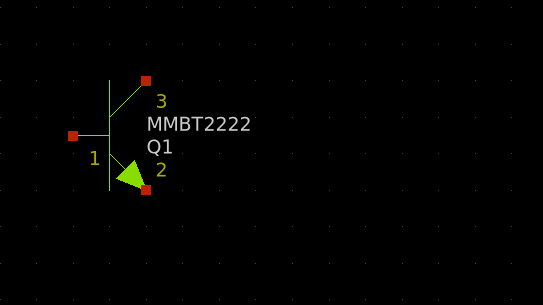 |
# ... The following commands will copy-paste the object and move it # using the "connect by kissing" feature: when separating connected # instances a wire is added. xschem select instance Q1 xschem copy xschem paste 0 0 xschem move_objects 120 0 kissing xschem unselect_all |
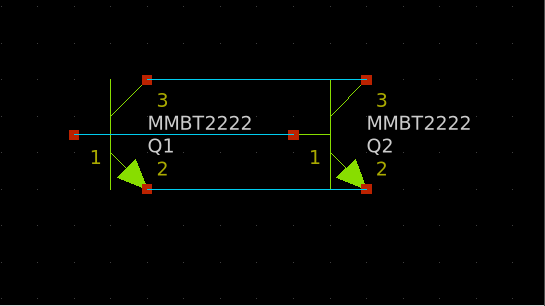 |
# In the following schematic we want to replace the nfet3/pfet3 with nfet and pfet # that have the bulk connection pin. |
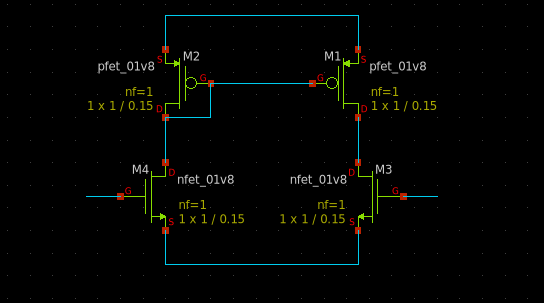 |
# select all instances that match "fet_01v8" model name
xschem search regex 1 model {fet_01v8}
set f {}
foreach i [xschem selected_set] {
# Replace fet3 with fet in symbol reference
set newname [regsub {fet3} [xschem getprop instance $i cell::name] {fet}]
xschem replace_symbol $i $newname $f
# remove body attribute since it is now assigned to the bulk pin
xschem setprop instance $i body fast
# the f parameter is for optimzing (avoid pushing undo at each iteration)
set f fast
}
xschem unselect_all
xschem redraw
|
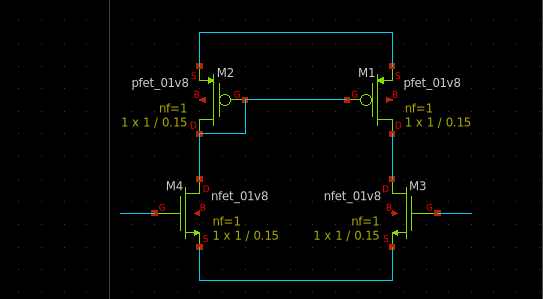 |